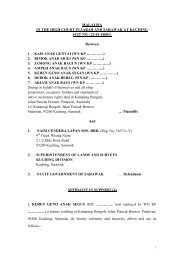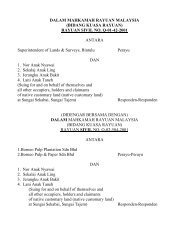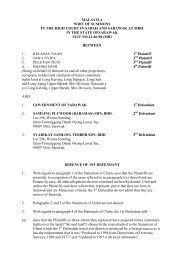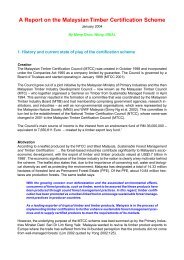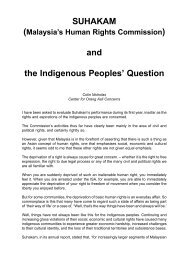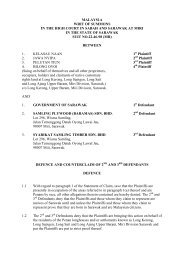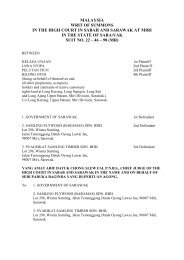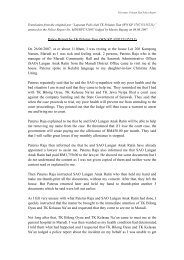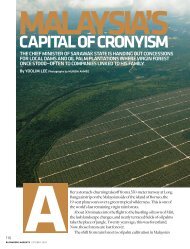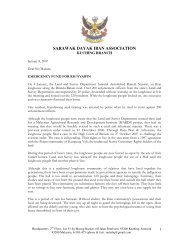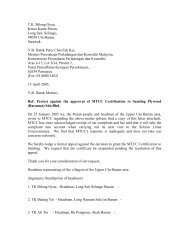Land Code (Amendment) Bill 2000 - Rengah Sarawak
Land Code (Amendment) Bill 2000 - Rengah Sarawak
Land Code (Amendment) Bill 2000 - Rengah Sarawak
You also want an ePaper? Increase the reach of your titles
YUMPU automatically turns print PDFs into web optimized ePapers that Google loves.
<strong>Land</strong> <strong>Code</strong> (<strong>Amendment</strong>) <strong>Bill</strong> <strong>2000</strong><br />
A bill the Natives of <strong>Sarawak</strong> will pay with all their<br />
customary land rights<br />
9 th May <strong>2000</strong><br />
- Chendang Hollis<br />
The <strong>Sarawak</strong> State Assembly sits again this week.<br />
If there is anything that the public in <strong>Sarawak</strong> in particular and all others in Malaysia or the world<br />
can expect from this sitting is that there will be an amendment to the existing ordinance relating to<br />
land-use in <strong>Sarawak</strong>. The new amendment will especially further restrictive limitation and or curbing<br />
of the natives in their claim for native customary rights over land.<br />
The State Assembly, with the exception of two opposition representatives from the DAP, is under<br />
the dominance of the Barisan Nasional (BN) government. In this sitting, the BN government is<br />
introducing a <strong>Land</strong> <strong>Code</strong> (<strong>Amendment</strong>) <strong>Bill</strong> <strong>2000</strong> for a major overhaul of the <strong>Sarawak</strong> <strong>Land</strong> <strong>Code</strong>.<br />
Indeed, once passed as it would, a process will be in place for the expeditious extinguishment (now<br />
the government claims that there will be no more ‘extinguishment’ but ‘termination’) of native<br />
rights to land.<br />
Preliminary note:<br />
While the statements made herein made reference to native customary rights (hereinafter<br />
‘the NCR’) land or native customary land (hereinafter ‘the NCL’), of which the natives<br />
of <strong>Sarawak</strong> claim land rights in accordance to their traditional and customary law<br />
and practice, the arguments are equally applicable to such land occupied by Malays for<br />
they acquire rights over land in similar manners. While it was not clearly provided that<br />
such customary land rights enjoyed by the Malays will be restricted, limited or curtailed,<br />
the proposed amendment specifically makes reference to such ‘natives rights’ as rights<br />
over native customary land or Government Reserves declared for the use of kampung or<br />
kampung reserves or similar purposes.<br />
What is installed in the <strong>Land</strong> <strong>Code</strong> (<strong>Amendment</strong>) <strong>Bill</strong> <strong>2000</strong><br />
The explanatory statement appended to the proposed amendment bill provides that the principle<br />
objectives of this amendment to the <strong>Sarawak</strong> <strong>Land</strong> <strong>Code</strong> (hereinafter the ‘SLC’) are:<br />
(a) to accord recognition to rights lawfully created by natives over untitled or State land or over<br />
native customary land or Government Reserves declared for the use of kampung or kampung<br />
reserves or similar purposes;<br />
(b) to harmonize the process and procedure for the resumption of land under native customary<br />
rights or within Government Reserve used as kampung or kampung reserves or similar<br />
purpose, with that of alienated land; and<br />
(c) to harmonize the process of adjudicating the amount of compensation to be paid for the<br />
termination of rights lawfully created over such native customary land or Government Reserve<br />
used for the purposes aforesaid.
Reading of the 19-pages proposed amendment bill in toto revealed “revolutionary” reconstruction<br />
of the <strong>Sarawak</strong> <strong>Land</strong> <strong>Code</strong> and the significant changes made to the <strong>Code</strong> which includes:<br />
1. the definition of “native rights”;<br />
2. the creation of new sections in the <strong>Code</strong> to provide for the creation of a Register of<br />
‘natives rights’ land;<br />
3. further restriction on the methods in the natives’ claim to possess NCR over land by<br />
deleting section 5(2)(f) ‘any other lawful methods’;<br />
4. the vesting of power with “the Director of <strong>Land</strong> in consultation with the Minister” in<br />
determining whether any grant should be issued to natives who had acquired rights by<br />
customary tenure to land;<br />
5. the deleting of section 82 of the SLC which originally provided that the general provisions<br />
for resumption of land by the government in Part IV does not include the ‘extinction<br />
of native customary rights’, and corresponding amendment to section 46, making<br />
provisions clearly for the purposes of extinguishing (‘terminating’) native customary<br />
rights;<br />
6. Shortening of period of time for claim of compensation for interests or rights over the<br />
land resumed by the government from 60 days to 45 days;<br />
7. substituting of the words ‘extinguishment’ and ‘extinguished’ as used in current SLC for<br />
extinguishment of native customary rights wherever they appear with the words ‘termination’<br />
and ‘terminated’.<br />
NCR <strong>Land</strong> has always been a contentious issue for decades and the continuing loss of NCR land to<br />
supposed “development” such as roads, dams, logging, oil-palm plantations, and other mega projects<br />
surfaced more prominently after the indigenous peoples continue to take more direct actions to<br />
protect their land. Such peaceful action as symbolic blockades and protests continue to surface after<br />
the affected communities receive no response from the authorities and companies concerned to<br />
request for dialogues.<br />
Before this proposed bill, the state government had been talking about 2 major changes that would<br />
be brought to the SLC, i.e. to enhance the legal recognition of the NCL and that there will be no<br />
more ‘extinguishment’ of native customary rights over land. Suggestion for the 2 proposed changes<br />
were approached with enthusiasm though cautions. It was said that by amending the SLC and to<br />
give NCL better legal recognition would enhance the value of NCL by facilitating financing, transfers,<br />
transmissions, inheritance and acquisition of NCL. With the assurance that there would be no<br />
more ‘extinguishment’ of native customary rights, it was thought that the state had finally come to<br />
its senses in recognising NCR.<br />
However, it was a surprise to many when the proposed amendment bill came in 19 pages, with 32<br />
items listed on the amendment bill.<br />
One may ask why should such a massive change be brought to the SLC.<br />
Though not exclusive, the SLC as it is could sufficiently provide for the recognition of NCL. In<br />
order to facilitate financing, transfers, transmissions, inheritance and acquisition of NCL, what is<br />
needed are clauses providing for the recognition and protection of NCL. In addition, provisions can<br />
be made for mechanisms to demarcate the boundaries of NCL, issue titles of perpetuity (as the<br />
customary practice would have accorded them) and remove all restrictions (such as clauses limiting<br />
the scope of NCL) on claims to NCL. Furthermore, amendments to repeal such clauses providing<br />
for the ‘extinguishment’ of NCR land will provide more certainty to the recognition of NCL.<br />
Unfortunately, such political promises are never meant to be.
‘Extinguishment’ and ‘termination’ of NCR over land<br />
On the issue of ‘extinguishment’ of NCR over land, the proposed amendment bill now seeks to<br />
“substitute the words ‘extinguishment’ and ‘extinguished’ wherever they appear in various sections<br />
(sections 4, 15, 33A, 94 or 141) of the SLC with the words ‘termination’ and ‘terminated’<br />
respectively”.<br />
It will be interesting to find out how the state BN government will justify that ‘termination’ of NCR<br />
over land does not equate or that it does not carry the same meaning as ‘extinguishment’ of NCR<br />
over land!<br />
“Natives rights” over land<br />
Under the proposed amendment, it provides that “native rights” over state land means rights described<br />
in section 7A(1), created by or belonging to a native over land not issued with a document<br />
of title.<br />
Sections 7A, 7B, 7C, 7D and 7E are new sections proposed to be included in the SLC. The “native<br />
rights” over state land in section 7A(1) refers to<br />
a) rights lawfully created pursuant to section 5(1) or (2) ;<br />
b) rights and privileges over any land declared as a Native Communal Reserves under section<br />
6(1); and<br />
c) rights within a Government Reserve declared under section 7(1) to be used as a kampung,<br />
kampung reserves or any similar purposes.<br />
It is noted that NCR land created under section 5 must be by the methods stated under section 5(2)<br />
and with a permit from the District Officer given under section 10 of the SLC. Section 5(1) provides<br />
that no recognition shall be given to any NCR over land in <strong>Sarawak</strong> created after 1.1.1958 but<br />
NCR may be created by methods specified in section 5(2).<br />
The former section 5(2) provides that the methods by which native customary rights may be acquired<br />
(the amendment bill provides that ‘acquired’ be substituted by ‘created’) are:<br />
a) the felling of virgin jungle and the occupation of the land thereby cleared;<br />
b) the planting of land with fruit trees;<br />
c) the occupation or cultivation of land;<br />
d) the use of land for a burial ground or shrine;<br />
e) the use of land of any class for rights of way; or<br />
f) any other lawful methods (now proposed to be deleted).<br />
no<br />
recognition<br />
The principal purpose of the SLC of 1958 in this aspect is clear, i.e. that there shall be no more NCR<br />
land to be created after 1.1.1958 but that such NCR land created before 1.1.1958 in accordance to<br />
section 5(2) and still subsisting, may be recognised. Unfortunately, section 5(2) itself places limitations<br />
and restrictions on the scope of NCR land to be recognised as there is no provision that the<br />
boundaries of such NCR land are to be determined in the spirits and methods of the customary laws<br />
and practices of the affected indigenous communities.<br />
Because of the provisions above and based on the pre-amendment SLC, it loses all purposes and<br />
meanings for the registration of NCL and this being the major cause that sparked off the disputes,<br />
discontentment and the ongoing struggle of the native communities over their land rights. The<br />
native communities insist that their NCL should be accorded statutory force in accordance with<br />
their customary laws and practice with regards to creation or acquisition.
With such conflict of principles, it is hence doubtful if there were NCL created or acquired on or<br />
after 1.1.1958.<br />
Yet the proposed amendment provides for the registration of NCL with rights acquired or created<br />
after 1.1.1958 of which there is, most likely, none!<br />
The proposed deletion of section 5(2)(f)<br />
Without any clarification or explanation in the explanatory statement, the proposed bill seeks to<br />
delete this section which provides that the native communities and or individuals may acquire NCR<br />
over land by “any other lawful methods”.<br />
This proposed amendment is most detrimental to the native communities because subsection (a) to<br />
(e) of section 5(2) severely curtailed the rights of the natives to their NCL as are rightfully theirs<br />
pursuant to their adat (customary law and practice). The often-cited examples are that the watercatchment<br />
areas, communal forests and or any other components of land sanctioned as “menoa”,<br />
“pulau”, “tanah penurip” etc, recognised under their customary practices, do not fit into any of the<br />
subsection from (a) to (e). Subsection (f) provides for the only means that may be relied upon by<br />
the natives to claim such land rightfully theirs in accordance to their customary law and practice, by<br />
taking “any other lawful methods” to means “customary law and practice”. With the deletion of<br />
s5(2)(f), any claim under the adat will be completely curtailed.<br />
The Register of native rights<br />
The Register of native rights is a separate register from the present statutory Register as provided<br />
under Part VII of the SLC. This is clearly seen from the amendment to the definition of “Register”<br />
which shall now reads:<br />
“Register” means the Register kept under Part II but does not include a Register<br />
of native rights kept under section 7A(2).<br />
Therefore, on the outset, many believe that since the state government is attempting to register all<br />
native rights over land, the amendment should be welcomed and supported. Such belief is, unfortunately,<br />
a far cry from the intention of the amendment.<br />
The new sections 7A, 7B, 7C, 7D and 7E made provision for the registration of native rights;<br />
transfer, transmission, inheritance or acquisition of native rights; remedies; effect of registration;<br />
and protection against the government, are meaningless for as far as rights of natives to customary<br />
land are concerned.<br />
Separated from the statutory Register, this Register of native rights is at best only a record of the<br />
NCR land with the landmass much curtailed in the process of registration.<br />
Section 7A(1) provides for the registration of only untitled (i.e. without document of title) land<br />
claimed to be held under native rights, but the manner of registration is yet to be specified. Even if<br />
a special document of title was given, it is unlikely that such title is of any value. This could be<br />
concluded from the fact that any land claimed to be held under native customary rights and practice<br />
being registered are expressly excluded and shall not be registered in this Register of native rights,<br />
as provided under section 7(3).
The contention that the Register is only a meaningless record can be further substantiated by the<br />
amended section 49 wherein subsection (5) provides that notwithstanding even if the Superintendent<br />
serves a notice on any person he believes to have rights created over any land (with the Register<br />
of native rights, it may be argued that there is now protection of the natives since there will be<br />
notice of such rights existing over disputed land) it shall not be deemed to be an admission or an<br />
acknowledgment on the part of the government that the person to whom the notice is addressed has<br />
any rights over such land.<br />
The new section 54A made specific provision for the resumption of non-titled land and it states:<br />
“Where the Superintendent has taken possession of any Native Customary <strong>Land</strong> or<br />
land previously constituted under section 7 as a Government Reserve, such land shall<br />
be vested in the Government free of and unencumbered by any native customary rights<br />
and shall revert to the Government and if any rights over such land are registered<br />
under section 7A, an entry be made in the Registered of Native Rights of the termination<br />
of such rights and the land may be alienated in accordance with section 13.”<br />
Together with the deleting of section 82 of the SLC which originally provided that the general<br />
provisions for resumption of land by the government in Part IV does not include the ‘extinction of<br />
native customary rights’, and corresponding amendment to section 46 making provisions clearly<br />
for the purposes of extinguishing (‘terminating’) native customary rights, all native rights to land<br />
effectively vanished in thin air.<br />
In such a case, any registration will be rendered meaningless too. Any hope that transactions may<br />
be effected for transfers, transmission, acquisition or inheritance and that such transactions may be<br />
financed by banking institutions etc are mere illusions since the Register is no conclusive proof of<br />
ownership to the land.<br />
Many natives who have attempted to register their NCR land have also the experience that registration<br />
are made on prescribed forms and they are to state their claims as provided under section 5(2)<br />
and this means that they are unable to register rights over land in accordance to their customary law<br />
and practice. The same is true of the Register of native rights. The further limitation, restriction and<br />
curtailment of section 5(2), by the deletion of subsection (2)(f), serves no purpose for the registration.<br />
No more extinguishment of NCR <strong>Land</strong>? Yes, but termination. Recognition of NCR land by the<br />
process of registration? Yes, but what extent of NCR land and for what purposes?<br />
The battle of the natives in <strong>Sarawak</strong> to rights under their adat to protect their NCR land is not help<br />
by this amendment bill. In fact, it is a bill too dear to be paid with all their rights and interests over<br />
their ancestral land!



